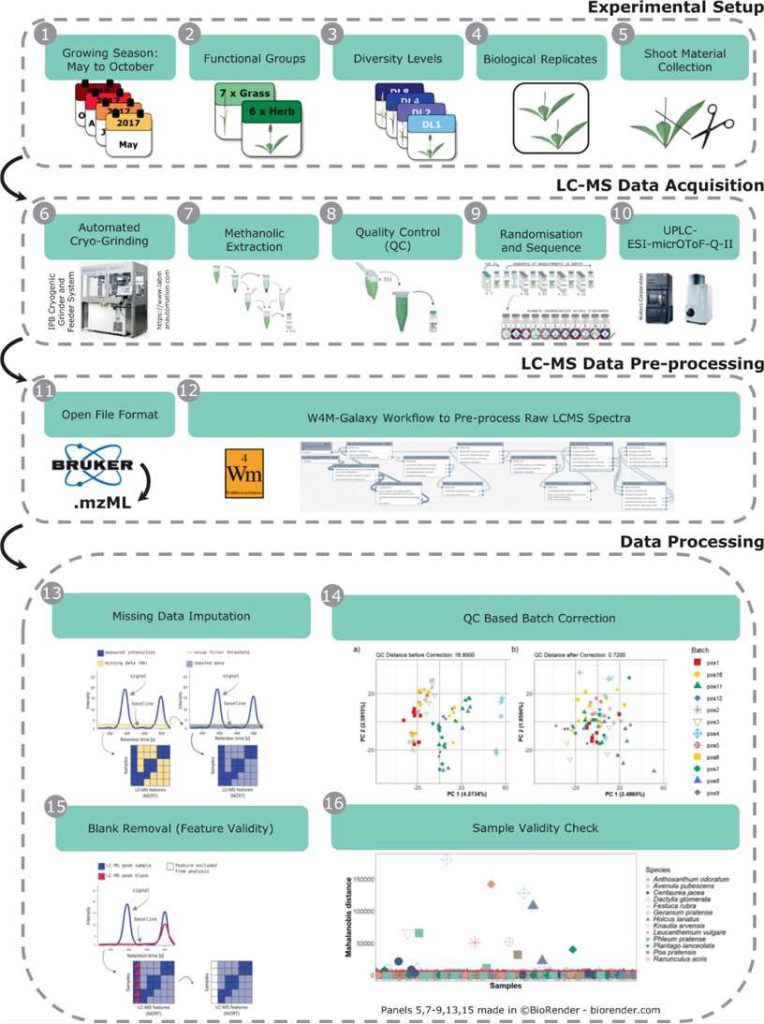What is metabolomics approach in plants?
The metabolomics approach in plants involves a comprehensive and systematic analysis of the complete set of metabolites present within plant tissues. Metabolites are small molecules that are the end products of cellular processes, reflecting the biochemical status of a biological system at a given point in time. The metabolome represents the entire complement of these metabolites, providing a snapshot of the physiological state of a plant.
One of the key aspects of the plant metabolomics approach is the utilization of advanced analytical techniques to identify and quantify a wide range of metabolites. Mass spectrometry and nuclear magnetic resonance spectroscopy are commonly employed for this purpose. These techniques enable researchers to detect and measure various classes of metabolites, including sugars, organic acids, amino acids, lipids, and secondary metabolites.

Data set overview (Marr et al., 2021).
The primary goal of plant metabolomics is to unravel the complex metabolic networks and pathways that govern the biochemical processes within plants. By understanding the composition and abundance of metabolites, researchers can gain insights into the fundamental aspects of plant metabolism, such as energy production, nutrient utilization, and responses to environmental stimuli.
Plant metabolomics is particularly valuable in studying dynamic changes in metabolite profiles under different conditions. For example, researchers can investigate how plants respond to abiotic stresses like drought, salinity, or extreme temperatures by monitoring alterations in the metabolome. This information is crucial for elucidating the mechanisms plants employ to cope with environmental challenges.
Moreover, the metabolomics approach facilitates the identification of key biomarkers associated with specific physiological processes or developmental stages in plants. These biomarkers serve as indicators of the plant's health, stress tolerance, or nutritional status. Understanding these markers contributes to the development of strategies for crop improvement, as researchers can identify traits related to yield, disease resistance, and nutritional content.
Targeted and Untargeted Approaches in Plant Metabolomics:
In the realm of plant metabolomics, researchers employ both targeted and untargeted approaches to extract meaningful insights from the vast array of metabolites present within plant tissues.
In targeted metabolomics, researchers focus on a predefined set of metabolites, typically those involved in specific pathways or processes. This approach allows for precise quantification and identification of known compounds. For example, researchers might target a specific group of secondary metabolites, such as flavonoids or alkaloids, to gain insights into their roles in plant defense mechanisms or interactions with the environment. Targeted metabolomics is particularly valuable when investigating known pathways or when the research question is narrowly defined.
Plant Untargeted Metabolomics:
Untargeted metabolomics, on the other hand, takes a more comprehensive and exploratory approach. It involves the analysis of the entire metabolome without focusing on specific metabolites. This approach is unbiased and is especially useful when researchers aim to discover novel compounds or pathways that might not have been previously characterized. Untargeted metabolomics is well-suited for studying complex biological systems, as it allows for the identification of unexpected or unknown metabolites. This approach is beneficial when the scope of the study involves understanding global changes in the plant metabolome in response to various stimuli, such as environmental stresses or genetic modifications.
Integration of Targeted and Untargeted Approaches:
Combining both targeted and untargeted metabolomics approaches provides a more comprehensive understanding of plant metabolism. Targeted analysis helps validate specific hypotheses and provides detailed information about known metabolites, while untargeted analysis allows for the discovery of new and unexpected metabolites. This integrated approach is powerful in elucidating the intricate interplay of metabolic pathways and identifying key metabolites that play critical roles in plant growth, development, and responses to environmental factors.
The choice between targeted and untargeted metabolomics depends on the research objectives and the level of detail required. While targeted approaches offer precision in studying specific pathways or compounds, untargeted approaches contribute to the broader exploration of the plant metabolome, uncovering novel insights and potential biomarkers. By strategically employing both strategies, researchers can harness the full potential of plant metabolomics to address diverse scientific questions and contribute to advancements in agriculture, medicine, and environmental science.
What are the applications of plant metabolomics?
Understanding Plant Physiology:
Plant metabolomics aids in deciphering the physiological processes within plants. By profiling metabolites, researchers can identify key biomarkers associated with growth, stress responses, and various developmental stages, contributing to a deeper understanding of plant physiology.
Studying Environmental Responses:
Plants continually interact with their environment, responding to factors like temperature, light, and nutrient availability. Metabolomics allows the investigation of how plants adapt to environmental changes, providing insights into stress tolerance mechanisms and environmental responses.
Crop Improvement:
Metabolomics is integral to crop improvement programs by identifying metabolites linked to desirable traits. These traits may include disease resistance, nutrient content, and overall nutritional quality, guiding breeding efforts to develop resilient and nutritionally enhanced crops.
Pharmacological Applications:
Many plant metabolites possess medicinal properties. Metabolomics aids in the identification and characterization of bioactive compounds, contributing to drug discovery and the development of natural products for pharmaceutical purposes.
What are the primary and secondary metabolites of phytochemicals?
In the intricate world of plant biochemistry, phytochemicals represent a vast array of naturally occurring compounds that contribute to the unique flavors, colors, and medicinal properties of plants. These phytochemicals can be broadly classified into primary and secondary metabolites, each playing distinctive roles in the overall functioning and survival strategies of plants.
Primary metabolites are fundamental compounds that are essential for the basic cellular functions of plant life. These molecules are involved in primary metabolic pathways, sustaining vital processes such as growth, energy production, and cellular respiration. Common examples of primary metabolites include carbohydrates, which serve as the building blocks for cell walls and energy reservoirs (e.g., glucose, sucrose); amino acids, the essential components of proteins and enzymes (e.g., proline, glutamine); and nucleotides, the building blocks of nucleic acids (e.g., ATP, GTP). Primary metabolites are ubiquitous across all plant species and are critical for the core physiological functions that support plant life.
In contrast, secondary metabolites are specialized compounds that, while not directly involved in the essential life processes, play pivotal roles in the adaptation and survival of plants in their environments. Secondary metabolites often serve as defense mechanisms against herbivores, pathogens, and environmental stresses, as well as in attraction of pollinators. The classes of secondary metabolites are diverse and include alkaloids (e.g., quinine, nicotine), flavonoids (e.g., quercetin, anthocyanins), terpenoids (e.g., carotenoids, essential oils), and others. The production of secondary metabolites is often inducible, meaning that plants synthesize them in response to specific stimuli, such as herbivore attacks or changes in environmental conditions. Secondary metabolites contribute to the unique characteristics of different plant species and are of significant interest for their medicinal, nutritional, and ecological implications.
Reference
Marr, Sue, et al. "LC-MS based plant metabolic profiles of thirteen grassland species grown in diverse neighbourhoods." Scientific data 8.1 (2021): 52.
